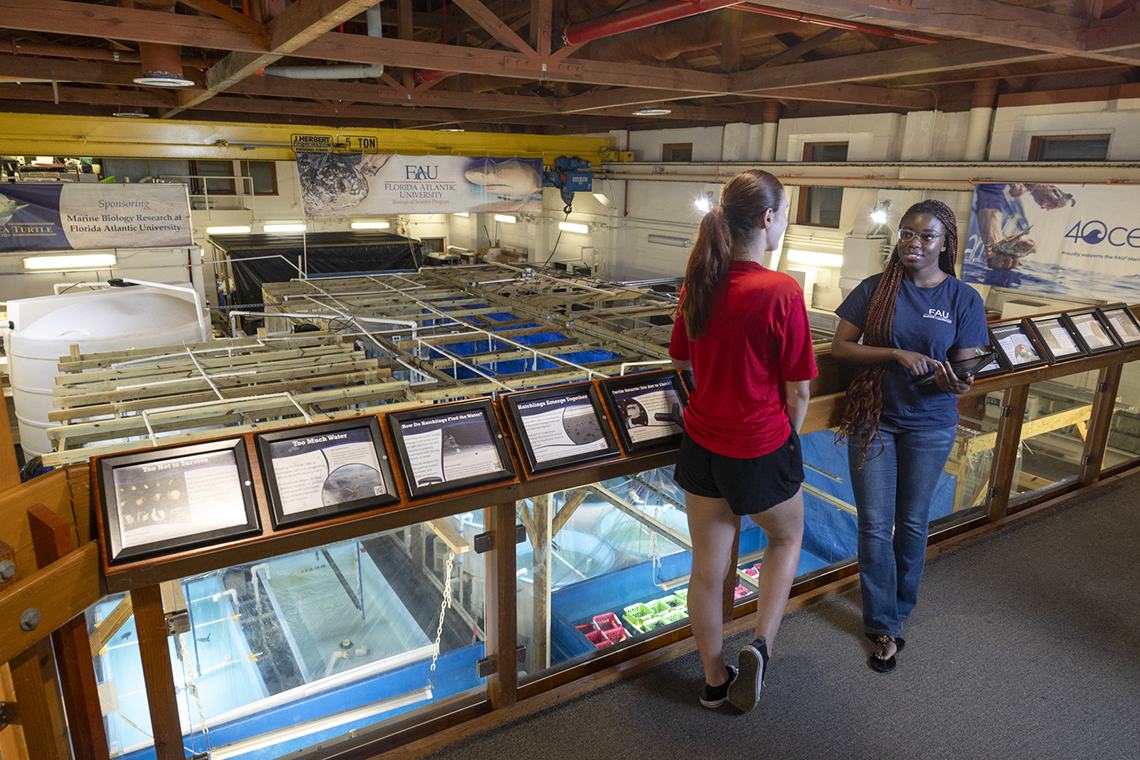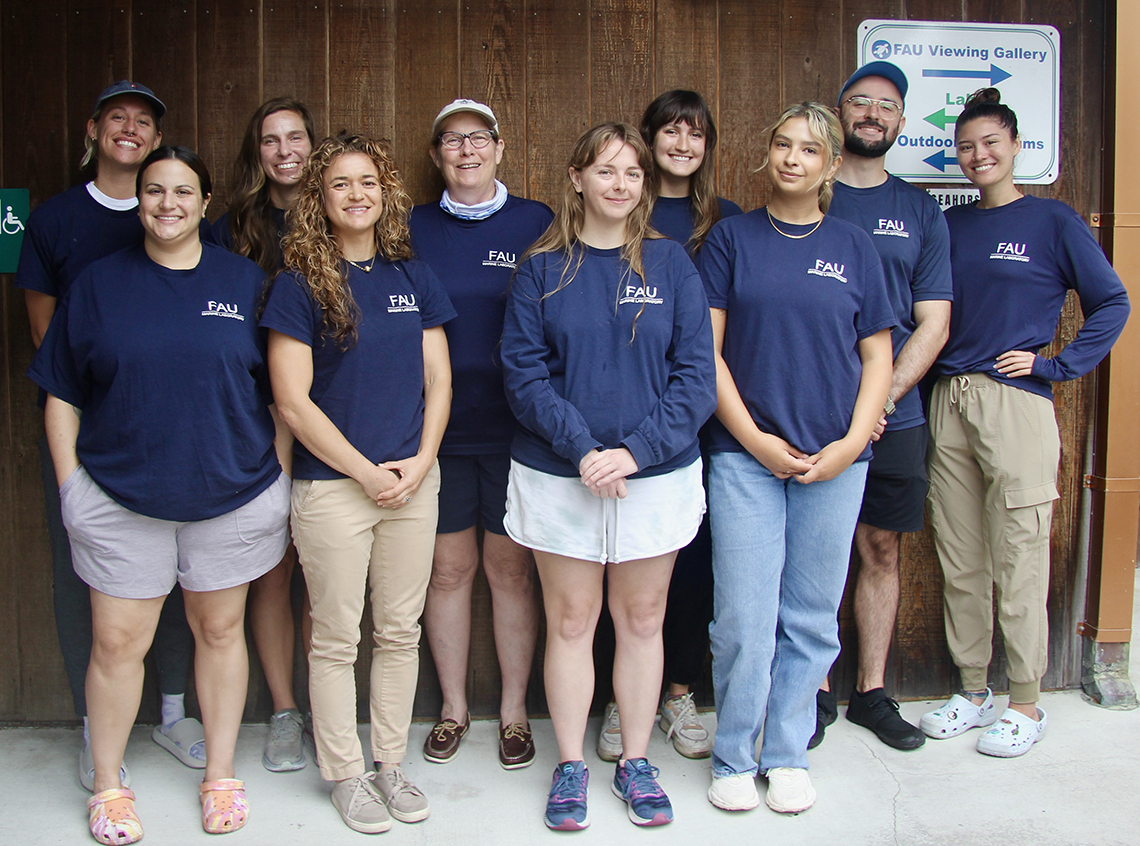Follow Us!

We welcome educators and curious minds alike to use the free educational resources featured here. The FAU Marine Lab is committed to communicating our scientific findings to broad audiences and promoting environmental literacy and ocean stewardship. The educational resources below are carefully crafted by an interdisciplinary team of talented FAU scientists and scientists-in-training from the Glenn W. and Cornelia T. Bailey Marine SEA Scholars Program with backgrounds ranging from the sciences to education, the arts, and humanities. Dive in and introduce your students, kids, family, and friends to various kinds of marine life and the research discoveries made by the Marine Lab’s scientists.
Nearpod virtual experiences created by our team consist of engaging lessons related to the Marine Lab’s research topics with fun, interactive games. Our lessons are accessible free of charge. These lessons can be led by the educator in a classroom or can be done at an individual’s own pace. Lessons incorporate pre- and post-interactive games to gauge participants’ understanding of lesson concepts. To access a lesson, click on the corresponding tile photo and enter the corresponding lesson code found under the featured thumbnails:
Bring the ocean into your classroom! This lesson plan is designed for grades 3-5 and can be modified for younger students. The slide show edition allows for educators to present these materials to students who may need more guided instruction. Students will learn about the differences in sea turtle shell anatomy between loggerhead and green sea turtles, and how these differences are useful in species identification and scientific research.
Sea Turtle ID: Whose Shell Could it Be? An Interactive Lesson and Game
Sea Turtle ID: Whose Shell Could it Be? An Interactive Lesson and Game (slide show edition)
How do sea turtles swim? These interactive 3-D models provided by DigitalLife3D on Sketchfab can be rotated along any axis of the sea turtle to observe sea turtle swimming motion. Immerse yourself, friends, family, or students in the form and function of both leatherback and green sea turtle flippers with these free models. Zoom in on the model to get a close-up of their features such as their shell, eyes, mouth, and more!
This juvenile leatherback sea turtle model was created using photographs and measurements from one of FAU Marine Lab’s own study turtles in collaboration with the nonprofit organizations, Digital Life 3D and Upwell. This young leatherback sea turtle will grow to be the largest of all sea turtles (up to 7 feet long, with some reaching 2,000 pounds in weight). Look at how long its flippers are compared to its body. These long flippers are necessary for leatherbacks to be able to swim efficiently in the open ocean. Unlike other sea turtles that may nestle themselves in seaweed patches or under coral structures, leatherbacks swim almost continuously. Their leathery shell allows them to withstand the pressures found at extreme ocean depths. Leatherbacks dive deeply to feed on their preferred prey, jellyfish and salps. Yum!
Look closely at the underside of the leatherback sea turtle’s jaw and you will see a pair of fang-like structures called cusps. These cusps help the leatherback sea turtle grasp and cut jelly animals into mouth size bites and also prevent prey from escaping.
Model 74A - Juvenile Leatherback Sea Turtle
This green sea turtle is missing one of its flippers! This turtle was rescued in 2016 at the Blowing Rocks Preserve in Jupiter Island, Florida, by the Loggerhead Marinelife Center after surviving a shark bite. Photographic data collected of the turtle, affectionately named Scallywag, was used to create this model in collaboration with the nonprofit organizations Digital Life 3D, and Upwell, with the FAU Marine Lab. A fully grown adult green sea turtle can be 3 to 4 feet long and weigh 300-350 pounds. Most ocean predators would be too small to prey on a turtle this size, but that doesn’t mean they are totally safe. Large predators like tiger sharks can still hunt and eat even adult turtles.
Ocean predators are not the biggest threat sea turtles face. Human impacts on sea turtles through pollution, illegal harvesting, and boating accidents are much more serious threats. Green turtles are “keystone” species, meaning they are an essential part of their environment, and their presence affects multiple species in an ecosystem. Threats to sea turtles can have widespread impacts. For example, green sea turtles are herbivores that eat seagrasses. They are the ocean’s landscapers, maintaining beds of seagrass; their grazing helps maintain seagrass which is a nursery habitat for a variety of other species.
Model 46A - Subadult Green Sea Turtle
Our coloring sheets are designed to engage younger age groups with the exciting research conducted at FAU Marine Lab. The animals featured are drawn in an anatomically correct fashion, and accompanying fun facts are to introduce curious minds to concepts pertaining to their unique biology, and how FAU Marine Lab researchers study these animals.
Loggerhead Sea Turtle Weigh and Measure Coloring Sheet
Are you interested in learning what kind of animals your personality most aligns with? Are you looking to test your seagrass knowledge? Look no further than our engaging quizzes! These fun quizzes were designed to be both informative and interactive, educating about a variety of animal behavior and plant functions. Explore our quizzes below to learn more about the fascinating marine life our lab studies!

Have a science question related to marine biology? Ask the Experts!
Have you ever wondered how long a sea turtle can stay underwater? Or how sharks use their senses to hunt? Marine biologists await your ocean related questions! Click below to submit your question and follow us on Instagram or Facebook to see the answer.

These virtual resources were created by students in the Glenn W. and Cornelia T. Bailey Marine SEA (Science, Education, and Arts) Scholars program. This unique program recruits talented undergraduate and graduate students from various colleges and disciplines across Florida Atlantic University who serve as ocean ambassadors, engaging the public with the Marine Lab’s scientific discoveries. To learn more about this program, visit our Marine Lab Scholar Program page.